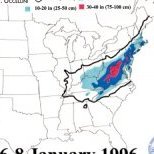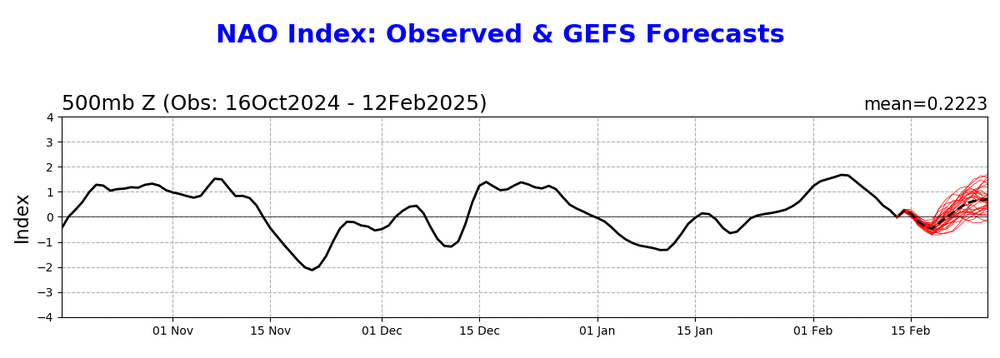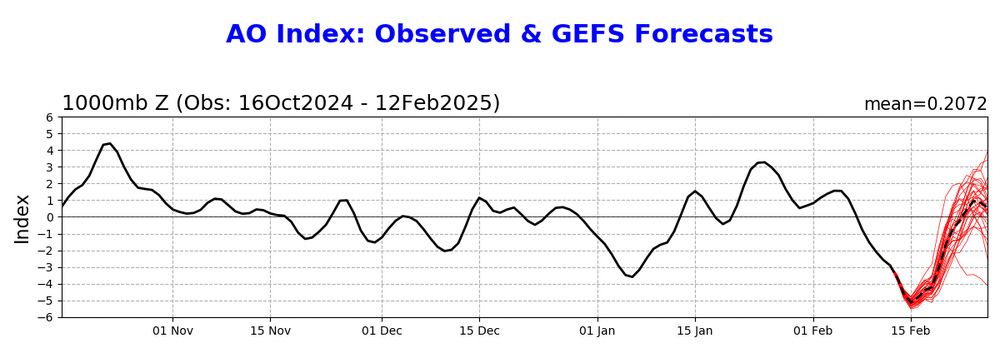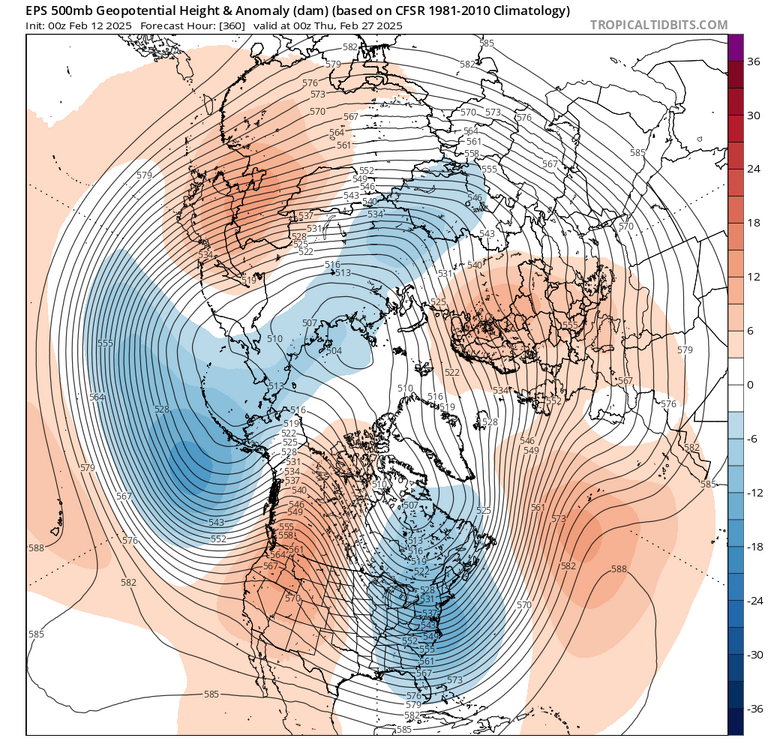-
Posts
7,960 -
Joined
-
Last visited
Content Type
Profiles
Blogs
Forums
American Weather
Media Demo
Store
Gallery
Everything posted by EastonSN+
-
And that's the difference that was the polar vortex to our North which is completely different than this year which is blocking based. New England has had a warm winter as opposed to that year where it was frigid for them.
-
-
What's hilarious is that this is not a negative EPO it's a positive PNA but yet the trough is in the same spot lol.
-
No this looks like just a repeat generally of December and January where the trough access is in a bad spot for us.
-
Right around the 20th which is when we have that wave passing to our South.
-
Remember the h5 setup was completely different. Also not just specifically speaking of that one storm event but rather the season as a whole which had some frigid ice storms.
-
-
For those wanting an early spring like me this does not look good. To add insult to injury as with the last 2 months the trough is too far east. Perhaps we get another Southeast or Mid-Atlantic storm.
-
It could be in would explain why we're getting these intense blocking episodes so frequently. This also leads to my point which was raised in a New England forum about a bootleg block which is not the typical one which gives us a KU event but rather a heat induced block which does not have the same effect and fails more often than not. This would explain why 2021 the block succeeded in giving us a lot of snow wow last 3 years it has not. That being said the last two years is really historically low rnas. This year the block helped the middle alantic in the southeast like Atlanta New Orleans Destin Florida Ocean City Maryland etc etc. so maybe it is not a bootleg block. Also this means that the southeast in Mid-Atlantic does not care if the southeast ridge is linking up to the blocking because they're still getting lots of snow it just affects Northern latitudes for some reason. I get it weaker storms slide East while intense storms cut, but that just proves my point that it's the stronger storms pumping up the southeast ridge not the other way around.
-
-
Going back to the southeast ridge making up to the AO, Don provided statistics which showed that it did indeed happen before, it just increased in frequency. Well if we are getting more blocking more often and in high intensity then the chances of it linking to the southeast ridge would increase to because there's more blocking episodes. Again Don proved it happened in the past so for increasing blocking episodes there's more chances for linking up to the southeast ridge.
-
Also for any met as I've asked this question a lot of times, why are we hyper focused on the water temperatures in Indonesia and off Japan and yet we continuously ignore the Indian Ocean water temps which are rising extremely quick. If we are to argue that we are going to be in the warmer phases of the mjo because of the Indonesian water temperatures than the same has to be true for phases 1 and 2 which are colder for us and a result of rising Indian Ocean temperatures The historic cold outbreak in January was the results of a high wave in phase one. Can't be a coincidence. I hope someone acknowledges this question as for some reason it's ignored over and over again with regards to the Indian Ocean temps.
-
I don't like the 93/94 or 13/14 comparisons as the h5 setup was completely different in those years. If we had the same setup today we would get the same results except a few degrees warmer. So instead of 14° and sleet it would be 17° and sleet. Not Florida breaking a record followed by a cutter.
-
What is also interesting is we are by no means lacking cold air like we saw in the last two years because of the historic rnas which brought historic cold to the West and California. This is purely a storm track issue not temperature. What is also interesting is for a lot of years Washington DC was in a snow hole according to the Mid-Atlantic forum. No matter what the storms are always south or north of DC. Now DC is in the bullseye and one of the posters in the Middle Atlantic forum stated that the snow hole has just moved Northeast and is now over Philly and New York. I guess we can put Boston in there to a certain extent now. If it moved before it will move again. The positives are we are not lacking cold air. We are still snowing albeit little events. If it gets snow in Florida can snow here LOL. The atmosphere is always changing so we will break out of this its just how long.
-
This is the second linkage. Setting aside the trough which is too far west for us, look at the block. When you run the animation the block drops down in a rotation fashion and very briefly touches the southeast ridge which again is being pulled up by a large storm. Weaker storms just like the last one do not pump up the southeast ridge while the larger ones do. It has to be the storms pulling up the ridge.
-
The southeast ridge, or Western Atlantic ridge, links up to the block here however look to the west and that storm diving down into a deep trough in the West. The RNA in this depiction is what is likely causing the linkage not the southeast ridge flexing in and of itself pushing down the RNA.
-
I'm not an expert however if I were to guess I would say that the fast flow is causing the storms to not have enough time to gather enough moisture. Plus I've heard in the past where they say the storm ahead of it took the moisture out of the atmosphere. Not sure about that but could be the case as well.
-
Don I know you're busy, however you get a chance would you be able to see if getting too -4 standard deviation blocks in a single season is common or this is new territory. The number of blocks we received in the last 5 years seems extremely odd.
-
But my point is I don't think it's the southeast ridge flexing. If that were the case we would have continuous Southeast ridge which is not the case. Virginia just had a heck of a snowstorm. Florida broke a record this season. When I believe is happening are the intensity of the storms are increasing which of course would bring up the southeast ridge ahead of it not the other way around. The results are the same so the casual enthusiast will just chalk it up to rain. However it makes a huge difference when looking at weather for these Coast. If it was a Southeast ridge itself snowfall averages would be dropping in the Delmarva in Tennessee not the other way around.
-
What is causing the increased frequency of intense blocking? We keep getting blocking episodes over the past few years over and over again so it has to be increasing. I remember a couple of years ago in the New England forum there was a block that failed and it was discussed how the block formed. Ie was it a true block or was it heat induced which is called a bootleg walk. The key point here is the bootleg block will fail more often than not as opposed to 2021 which was a true block. Also when is the last year we had two negative four standard deviation blocks in the same year? That has to be new or extremely rare. Liberty Bell had a good question which was why are we seeing increased snowfall in the Middle Atlantic especially at Delmarva while we are dropping. You mentioned I have to do with a fast flow but does that mean the delmarva's snowfall average will continue to increase while we decrease? The fact still remains that the Middle Atlantic is still getting hit as is places like Kansas City St Louis Tennessee so on and so forth. That seems to be increasing in the last few years. What happened in New Orleans in Florida was absolutely incredible having the largest snowfall in their histories so yeah I believe what I mentioned before that the higher what are temperatures are feeling more intense storms. Perhaps in the past it really was this cold in Florida and New Orleans however they receive more snowfall in this event because of the higher temps in the Gulf.
-
I still can test that it needs to be investigated further. Kind of a chicken or egg thing regarding whether it's the southeast ridge flexing or it's the intense storms pulling up the southeast ridge. Also what no one seems to be suggesting is the location of the block. It's not just looking at a value and saying oh it's negative 4 or 5 or whatever, but where the block set up.
-

South shore Obs/Nowcast for Feb 11-12 light snow
EastonSN+ replied to Sey-Mour Snow's topic in New England
Actually just measured 1.8 pleasant surprise. I am 2 miles north of the Fairfield boarder. -

South shore Obs/Nowcast for Feb 11-12 light snow
EastonSN+ replied to Sey-Mour Snow's topic in New England
1.8 in Easton CT. 14.55 STD. -
The delayed schools again for the 100th time this year. Didn't measure yet 1 think this puts Central Park at 11.5?
- 338 replies











